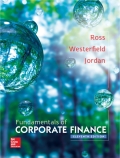
To find: The period when the machine must be purchased.
Introduction:
The variations between the
Answer to Problem 13QP
The company should purchase a machine at 2 years from the present at which the net present value should be high.
Explanation of Solution
Given information:
The company of Person X is planning to make its investment in a new machine. The new machine increases the cash flow by $273,000 per year. Person X has a belief that the technology that is utilized in the machine has a ten year life, it means no matter when the machine is purchased, it will be obsolete in ten years from now.
The current price of the machine is $1,400,000. There will be a decline in the machine to $95,000 for a year until it reaches $925,000. The required
Formula to calculate the net present value:
Note: The net present value is calculated by the above formula and this formula is used if the machine is bought today. PVIFA is the present value interest factor of an
Computation of the net present value:
Note: The value of the PVIFA at 14% for 10 years is 5.2161.
Hence, the current net present value is $23,999.57.
Note: It is not essential to buy the machine today, but it is essential to buy the machine when there is a higher net present value. It is necessary to compute the net present value every year. In order to make a right decision, the net present value for every year has to be taken at general date.
Formula to calculate the net present value:
Note: The net present value is calculated using the above formula and this formula is used only if the machine is bought today. PVIFA is the present value interest factor of an annuity.
Computation of the net present value for the Year 1:
Note: The value of PVIFA at 14% for 9 years is 4.9464.
Hence, the net present value at year 1 is $39,795.78.
Computation of the net present value for the Year 2:
Note: The value of the PVIFA at 14% for 8 years is 4.6389.
Hence, the net present value at year 2 is $43,413.12.
Computation of the net present value for the Year 3:
Note: The value of the PVIFA at 14% for 7 years is 4.2883.
Hence, the net present value at year 3 is $37,600.
Computation of the net present value for the Year 4:
Note: The value of the PVIFA at 14% for 6 years is 3.8887.
Hence, the net present value at year 4 is $24,639.48.
Computation of the net present value for the Year 5:
Note: The value of the PVIFA at 14% for 5 years is 3.4331.
Hence, the net present value at year 5 is $6,355.15.
Computation of the net present value for the Year 6:
Note: The value of the PVIFA at 14% for 4 years is 2.9137.
Hence, the net present value at year 6 is -$59,024.22.
The company must buy the machine at 2 years from now as the net present value remains the highest.
Want to see more full solutions like this?
Chapter 24 Solutions
Fundamentals of Corporate Finance
- What does the payback period refer to?arrow_forwardWhich of the following bonds offers the highest current yield? a. A(n) 3.78%, 19-year bond quoted at 38.893. b. A(n) 6.30%, 28-year bond quoted at 64.822. c. A(n) 1.89%, 23-year bond quoted at 19.447. The current yield of the bond in part a is ☐ %. (Round to two decimal places.) ...arrow_forwardExplain working capital? explain.arrow_forward
- You have the opportunity to purchase a 24-year, $1,000 par value bond that has an annual coupon rate of 11%. If you require a YTM of 7.7%, how much is the bond worth to you? The price of the bond is $ ☐ . (Round to the nearest cent.)arrow_forwardYou are considering investing $880 in Higgs B. Technology Inc. You can buy common stock at $25.88 per share; this stock pays no dividends. You can also buy a convertible bond ($1,000 par value) that is currently trading at $880 and has a conversion ratio of 30. It pays $52 per year in interest. If you expect the price of the stock to rise to $36.72 per share in one year, which instrument should you purchase? The holding period return on the purchase of the common stock would be %. (Round to two decimal places.)arrow_forwardHow can you determine the value/worth of a company?arrow_forward
- An investor is in the 24% tax bracket and lives in a state with no income tax. He is trying to decide which of two bonds to purchase. One is a(n) 9.03% corporate bond that is selling at par. The other is a municipal bond with a 6.44% coupon that is also selling at par. If all other features of these two bonds are comparable, which should the investor select? Why? Would your answer change if this were an in-state municipal bond and the investor lived in a place with high state income taxes? Explain. O A. The investor should select the corporate bond. Since the fully taxable equivalent yield of 8.47% is less than the 9.03% return on the corporate bond, the corporate issue offers a higher return and is the better buy. The decision very likely would change if this were an "in-state" municipal bond and the investor lived in a state with high income taxes. An "in-state" municipal bond would not only shield the investor from federal taxes but also from high state income taxes. OB. The…arrow_forwardHii Please solve this question by using appropriate method.arrow_forwardneed solhelp by real expert and true answer.arrow_forward
 EBK CONTEMPORARY FINANCIAL MANAGEMENTFinanceISBN:9781337514835Author:MOYERPublisher:CENGAGE LEARNING - CONSIGNMENT
EBK CONTEMPORARY FINANCIAL MANAGEMENTFinanceISBN:9781337514835Author:MOYERPublisher:CENGAGE LEARNING - CONSIGNMENT
